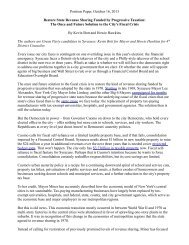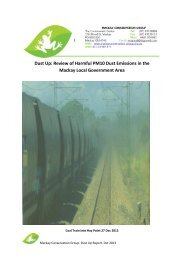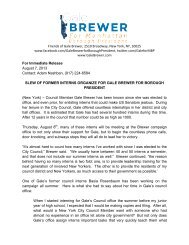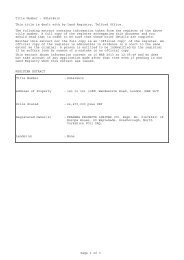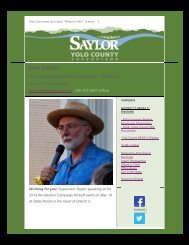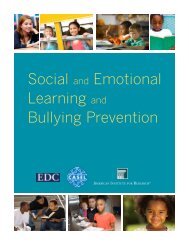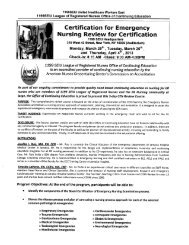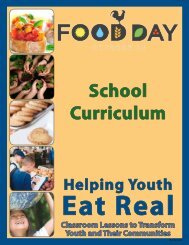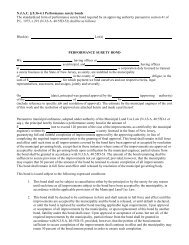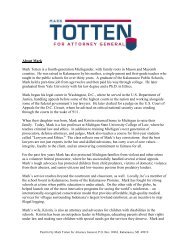Create successful ePaper yourself
Turn your PDF publications into a flip-book with our unique Google optimized e-Paper software.
Lesson 4: Navigate the Environment<br />
— Getting Started —<br />
Overview<br />
Now that students have learned the <strong>Food</strong> <strong>Day</strong> Eating<br />
Goals in Lessons 1–3, this lesson examines the strong<br />
influence our food environment has on what we<br />
eat. The food environment is everything from food<br />
advertisements to what is available in the corner store<br />
and from the ice-cream truck driving down the street<br />
to the garden in our neighborhood. Students learn<br />
that much of what is available in our food environment<br />
does not support the <strong>Food</strong> <strong>Day</strong> Eating Goals of<br />
“Eat Real,” “Mostly Plants,” and “Not Too Much.” For<br />
example, vending machines are packed with sweetened<br />
beverages and snacks that are overly processed<br />
and have more ingredients than we can count. Yet,<br />
at the same time, there are growing opportunities<br />
for wholesome eating, such as fruit and vegetable<br />
stands, farmers’ markets, gardens at schools and in<br />
the community, and families taking time to cook and<br />
eat together. Every time we choose what to eat, we<br />
vote with our food dollars. Therefore, we need to take<br />
opportunities to navigate through the challenges of the<br />
environment and seek out opportunities to “Eat Real.”<br />
The lesson ends with students making a Navigate the<br />
Environment Action Plan.<br />
Behavior Change Objective<br />
As a result of this lesson, students will be able to<br />
navigate the food environment to “Eat Real,” “Mostly<br />
Plants,” and “Not Too Much.”<br />
Learning Objectives<br />
Students will be able to:<br />
• describe the food environment in their<br />
community;<br />
• list at least two opportunities in their food<br />
environment that can help them meet the <strong>Food</strong><br />
<strong>Day</strong> goals;<br />
• create an action plan that navigates through their<br />
environment to make a choice that meets the <strong>Food</strong><br />
<strong>Day</strong> messages.<br />
Background for Teachers<br />
In developed countries like the United States, the<br />
food system makes processed food products available<br />
in an ever-widening array of choices. More than<br />
50,000 food items are available in U.S. supermarkets,<br />
and about 9,000 new brand-name processed foods<br />
are introduced each year. In addition, many overly<br />
processed foods and sweetened beverages are available<br />
all around us — from vending machines to<br />
mini-markets at gas stations to corner stores.<br />
Despite food seeming to be everywhere, access to<br />
health-promoting foods is more limited. Many people<br />
need transportation to reach a supermarket or a<br />
farmers’ market where fresh, whole foods such as<br />
fruits and vegetables are typically available. Often the<br />
places where students can pick up food on the way to<br />
school or after school have mostly overly processed<br />
food products and few wholesome foods.<br />
The information that surrounds food is complex as<br />
well. Billions of dollars are spent on food advertising<br />
every year and much of this is for less-healthful<br />
foods. Additionally, the way the media presents food<br />
and nutrition information is sensationalized and<br />
confusing. It takes critical thinking skills to competently<br />
navigate the information environment.<br />
Taken together, the food and information environments<br />
push us towards processed food products,<br />
sweetened beverages, and fast foods and pull us away<br />
from water, vegetables, fruits, and other whole foods.<br />
We hope Lessons 1–3 convinced you and your<br />
students of the importance of the <strong>Food</strong> <strong>Day</strong> Eating<br />
Goals of “Eat Real,” “Mostly Plants,” and “Not Too<br />
Much.” To meet these goals, we need to navigate<br />
through the challenges of the food environment in<br />
order to find healthful choices. This way, we take<br />
control and make positive changes.<br />
This lesson is about understanding our food environment<br />
and personally navigating through it. In the<br />
next, and final, lesson, you and your students will<br />
become advocates to create a better food environment<br />
for your community.<br />
54 | <strong>Food</strong> <strong>Day</strong> Lessons



